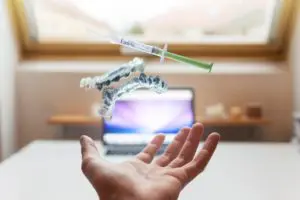Anesthesia: The 5 Different Options to Consider


1. Topical Anesthesia
The simplest and least invasive form of anesthesia is topical. While your dentist has more powerful chemicals, topical anesthetic is similar to products you may have used if you have ever purchased over-the-counter tooth pain ointment in your drug store.
Your dentist may use it to numb your gums or cheek to do some work in the area without causing you pain. She may also use it to numb an area before injecting a local anesthetic.
There are a lot of benefits to this type of anesthesia. It’s effective, it rarely interacts with other medication you might take, and you can drive yourself to and from the office.
2. Local Anesthesia
Local anesthesia is probably the most common form of anesthesia used. You may have heard the term “Novacaine,” although that is just one form of many. Your dentist uses a tiny needle to deliver anesthesia to the nerves around a tooth or an area that needs work, thereby blocking the pain.
Your dentist may use this for anything from fillings and root canals to tooth removal. It works quickly and wears off completely in a few hours.
Like topical anesthesia, a local treatment rarely interferes with other medication, and you can drive yourself home after your procedure.
3. Nitrous Oxide Gas
Nitrous oxide gas is still used by many dentists today. During the treatment, the doctor places a mask over the patient’s nose. Within a couple of minutes, feelings of nervousness or pain disappear, replaced with a sense of euphoria. You may even get the giggles. That’s one of the reasons it’s called “laughing gas.”
You and your doctor may choose this anesthesia to deal with pain and anxiety. It rarely interferes with other medications, making it safe for most people. Like a local anesthetic, you may still hear the sound of the drill, but with laughing gas, you probably won’t care. Because it is gas, it wears off quickly when you take off the mask. Most patients given nitrous oxide can drive themselves home after the gas has worn off.
4. Oral Anesthesia
Some dentists prescribe oral medications to make your dental procedures easier on you. Depending on the need, you can take a dose so small that it just takes the edge off your nerves or an amount so large that you are asleep.
Before you and your doctor choose this method, be sure to discuss your overall health and any medications you take. Many medications interfere with oral anesthesia and can cause problems. In addition, if you have ever watched those funny videos of kids coming home from the dentist, then you know it can take several hours for the medication to completely wear off.
5. IV Anesthesia
If you have extensive work, your doctor may suggest IV anesthesia. In this case, the dentist injects anesthesia directly into your vein. Depending on the medication, you can be out quickly and stay asleep for hours.
If you and your dentist decide on this course of medication, be sure to talk about your general health, any allergies you might have, and all medicines and supplements you take. Any of these can affect how IV anesthesia may work for you.
In addition to being more intrusive, IV anesthesia can take hours to wear off. Plan on someone else driving you home. Moreover, side effects such as nausea, shaking, headaches, and muscle cramps can all occur as the anesthesia wears off. Your dentist will require someone to accompany you to the appointment so they can drive you home.
Final Thoughts
Regardless of the type of anesthesia you and your dentist choose, it is essential to discuss your health, pain tolerance, and anxiety. There is no reason you should be uncomfortable. The last thing that Commonwealth Oral and Facial Surgery believe you should ever fear is a dental procedure.